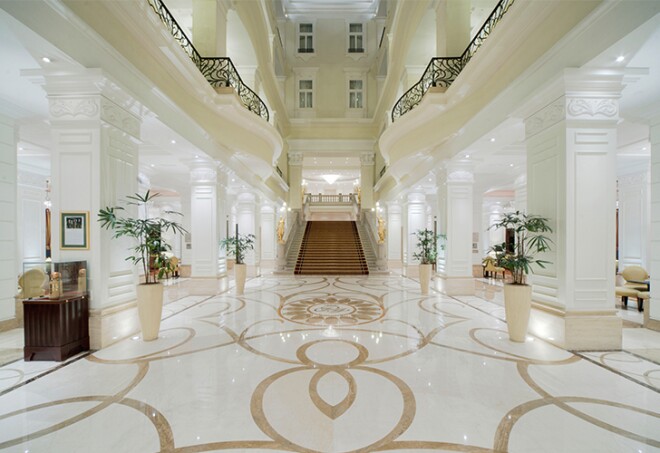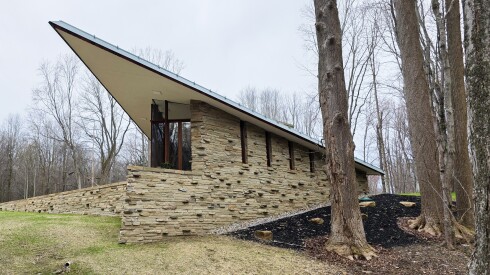Opened as the Grand Hotel Royal in 1896, the luxurious Corinthia Hotel has a long and storied past. It was here that the first film was ever screened in Budapest, and the building weathered fires and war before relaunching in its most recent incarnation in 2004. Travelers who really want to learn about the hotel’s history can take one of two weekly tours with manager Tibor Meskál, who has worked on and off here since 1961. Though the original interiors were demolished long ago, the property nevertheless retains a regal atmosphere. Italian limestone, Spanish marble, and gilded molding lend a sense of grandeur in the Grand Ballroom, a marble lobby is accented with swirling golden filigrees in the flooring, and guest rooms feature warm wood furnishings and creamy palettes. Even the leisure facilities skew toward the opulent: the courtyard-style indoor swimming pool is topped with a stunning stained-glass ceiling.
More Recommendations
Edgy Rooms in a Historic Hotel at the Corinthia Budapest
The term “Corinthian” was often used to indicate a man dedicated to the art of the pursuit of pleasure. But it could well serve as a stand-in for “dazzling.” After celebrating 120 years of royal elegance and hospitality, the Corinthia Hotel Budapest can bring a smile to the face of even the most jaded traveler with its classic design (think: baroque-style decorated ceilings, an opulent Grand Ballroom where even the legendary composer Béla Bartók user to conduct concerts, Italian limestone and Spanish marble and a grand lobby stairway that no Instagram shot can do justice to). Such a hotel legacy comes with a side dish of spectacular rooms, including the recently-refurbished Executive Suites. These, outfitted in tones of charcoal and gray, look a lot like pads fit for the pickiest Milanese fashionistas. The spacious Franz Liszt Suite is truly something of a marvel. It has a hallway, a living room that features stylistic sofas with carefully-curated multicolored silk pillows, textured wallpaper and plenty of fashion reference books from Lanvin to “The Grand Budapest Hotel.” The closet also features a floor to ceiling vanity area that makes you want to purchase a ball gown immediately and watch its over-the-top reflection in every corner. But yet, despite this Neo-classical nitpicking and an attention to detail that would make Wes Anderson proud, it feels so very much like home, with its lovingly worn-out timber floors and many vases. While the rest of the hotel is about plaster work and gilded scrolls, this suite feels like the Dark Horse, in every sense of the phrase. Could it be a bit of the British influence? Well, since it was designed by the English firm G.A. Design, there very well could be, and a chance to feel quite modern in a decidedly historic hotel.
At the Corinthia Budapest, a Cinematic Legacy and 120 Years of Habsburg-era Glory
Like a true grand dame hotel, the Corinthia Hotel in Budapest wears its age well. At 120 years old, the former Royal hotel constructed by the Swiss-born architect Rezső Ray (who designed many of the city’s public buildings) was one of the largest in Europe when it was first constructed in 1896, with 400 rooms and a staff of 200: unheard of in that day and age! The Royal Orpheum (now the effervescent hotel bar) opened its doors so many celebrities, including the American-born French dancer Josephine Baker; in this aspect (Baker was the first African-American woman to star in a major motion picture,” ZouZou”), it was way ahead of its time. But it still clings to its past: even though the hotel has been rebranded, many aspects from the signature swirlish “R” inscribed into the marble lobby entrance still carry the vestiges of the Royal legacy. Obviously, film has always played a starring role in the hotel’s image (the Lumière brothers debuted several movies at the Royal). If you envied Zero Moustafa’s gig in the eponymous Wes Anderson film who was inspired by the Corinthia property even though the film was made in Germany, you’ll realize that there are several white-gloved Zero aspirants in the hotel lobby, listening to your every wish. When the Pisani family (who owns properties in London and Malta) took over in 2003, the grand ballroom (which survived WWII bombs), with its fin-de-siècle neo-baroque details was restored to its former glory. I was fortunate enough to experience a gala dinner in that very ballroom, and marveled at the gilded details and paintings of luminaries that wrap around the walls. If you stay in one of the property’s 439 rooms, do a bit of dreaming, and revel in the Habsburg-style elegance that is in every detail.

























